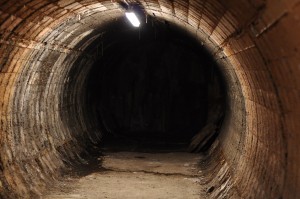“Tapestry of Space: Domestic Architecture and Underground Communities in Margaret Morton’s Photography of a Forgo en New York” by Irina Nersessova is an article about the psychogeography of homeless people. She discusses the connection that New York’s homeless have with the abandoned tunnels that were once used for public transportation, and delves into the emotion of the subject instead of solely focusing on numbers.
The most striking point that Morton makes when talked about in Nersessova’s article is that homeless people do, indeed, have a home. They can have a place where they feel safe and protected. However, homeless people are without a home that they can fully rely on. The tunnels have provided a sanctuary for many homeless because they are less likely to be in danger than if they were sleeping above the tunnels. Above ground is like a whole other world. It is a place of danger, death, and pain. Although this is true, most people above ground would never go into the deep, dark, abandoned tunnels, but Nersessova writes, “The absolute darkness of the tunnel prevents danger from entering it, which explains how it is possible to have the highest feeling of safety in a place that is perceived as most dangerous” (31). The homeless have to ignore their fear when they are searching for a safe place to rest. Those that are brave enough to face going into the tunnels for the first time can find a Utopia there. They can sleep without fear of being mugged, and they have a safe place to hide their valuables, and a quiet place to find themselves.
Although many homeless people do find safety in the tunnels, that sense of protection can be taken away in an instant. The police have the power to kick the homeless out of their safehouse. This boot back onto the streets is one hardship that the homeless population unfortunately has to face over and over again in their lifetimes. It can only be imagined how they must feel to lose the only protection that they have. The homeless had transformed the tunnels into their own personal space by creating art on the walls and constructing beds out of materials that represent the “splintered identity’s attempt to conform to the notion of a unified and solid self” (26). For the first time in a long time, they created a place for themselves where they did not have to worry about making it through the night. It is unbearable to think that the homeless are so coasted out from society that they are kicked out of places that no one even wants anymore.
A photographer that document the homeless and their experiences is refered to as flâneur. This flâneur is simply there to observe and take in their surroundings. They are described as being attentive to detail and easily distracted as to follow only the most captivating stories. The flâneur is thought to see the world as more than most people do. He can see the beauty when most see dirt, and he can follow the slightest detail that most otherwise would not have noticed. They are without fear as they approach strangers for interviews and explore dark tunnels for the next great shot.
It is so important to not lose touch with this story. It is easy to think of homeless people as inferior, but, in fact, they deserve no less than everyone else. They are treated like criminals for being homeless, but the setbacks that come from them being thought of as criminals (like getting locked out of the tunnels) makes it even harder on them to get back on their feet.

